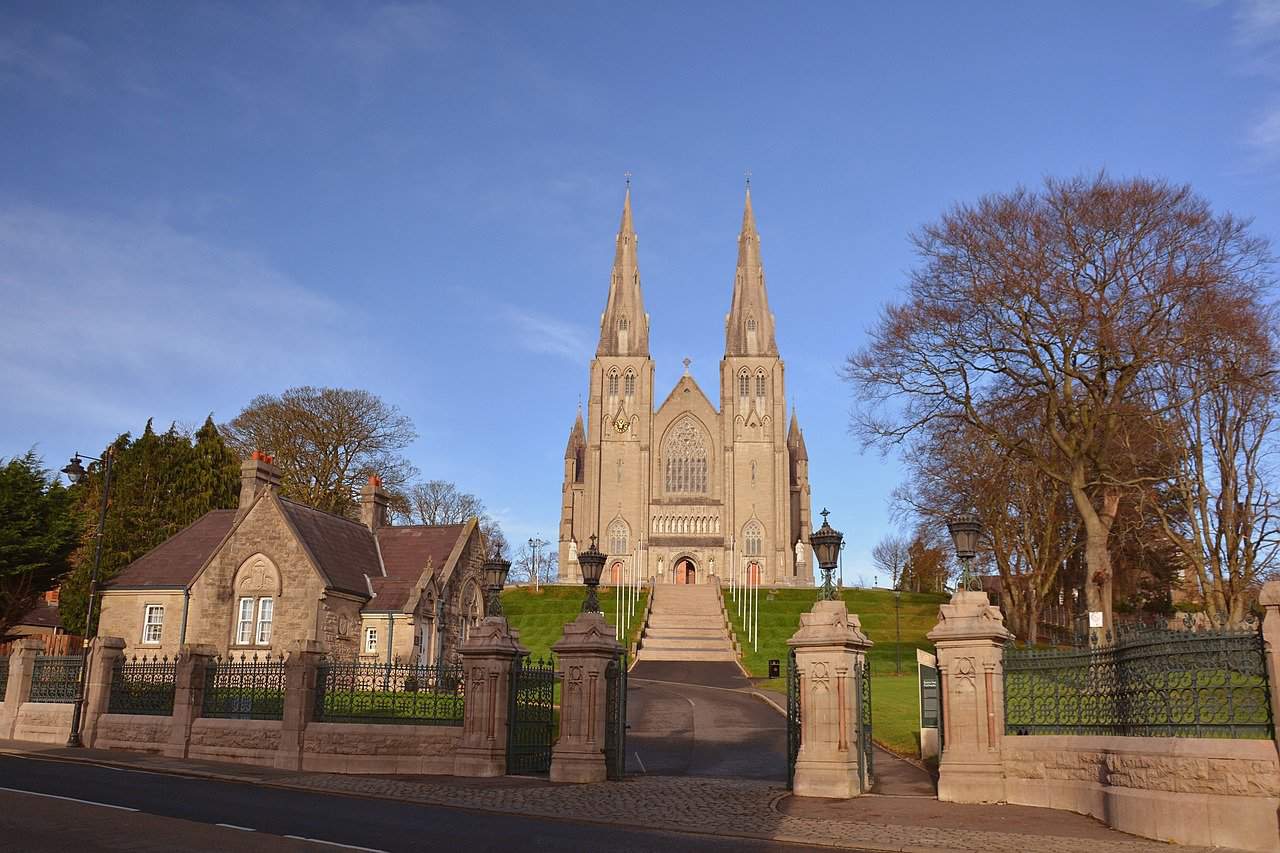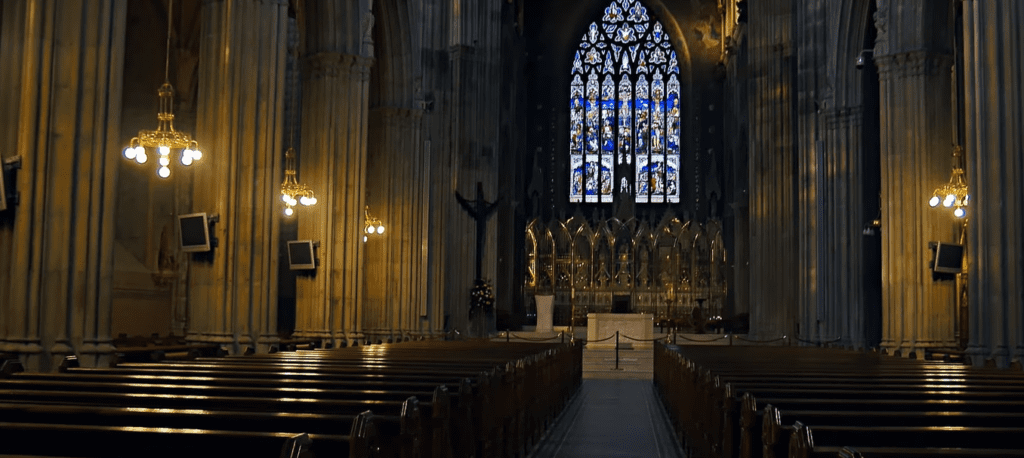360 Degree Video of St. Patrick’s Catholic Cathedral, Armagh

Updated On: April 22, 2024 by Yomna Salah
In the picturesque landscape of County Armagh, Ireland, where verdant fields stretch as far as the eye can see, there stands a majestic testament to Ireland’s enduring spiritual and cultural heritage—the St. Patrick’s Catholic Cathedral. Perched atop a hill overlooking the historic city of Armagh, this architectural marvel has been a cornerstone of religious life and cultural identity for centuries, drawing pilgrims, worshippers, and admirers from around the globe.
With its soaring spires, intricate stonework, and richly adorned interior, St. Patrick’s Cathedral stands as a symbol of Ireland’s devotion to its patron saint and its commitment to preserving its cherished traditions for generations. Join us on a journey through this iconic landmark’s storied history, architectural splendour, and cultural significance as we delve into the heart of St. Patrick’s Catholic Cathedral, Armagh.
The History Of St. Patrick’s Catholic Cathedral
The history of St. Patrick’s Catholic Cathedral is deeply intertwined with the legacy of St. Patrick himself, the patron saint of Ireland. Legend has it that St. Patrick, having converted the Irish people to Christianity in the 5th century, established a church on the hill of Armagh, which would later become the cathedral’s site. Over the centuries, successive waves of Christian pilgrims and settlers contributed to the growth and development of the church in Armagh, solidifying its status as an essential religious centre in Ireland.
The earliest recorded mention of a cathedral in Armagh dates back to the 7th century when the Diocese of Armagh was established. However, the current St. Patrick’s Cathedral owes much of its existence to the efforts of Archbishop Patrick Curtis, who initiated its construction in the mid-19th century. Designed by architect J.J. McCarthy, the cathedral’s Gothic Revival style reflects the prevailing architectural trends of the Victorian era, characterized by its pointed arches, soaring spires, and intricate stonework.
Architectural Splendor
Upon approaching St. Patrick’s Catholic Cathedral, visitors are immediately struck by its imposing façade, which is dominated by twin spires that reach the heavens. The intricate detailing of the exterior, including delicate carvings and elaborate stained glass windows, speaks to the craftsmanship of the artisans who laboured to bring McCarthy’s vision to life.
Stepping inside, visitors are greeted by a sanctuary of sublime beauty and serenity. The cathedral’s soaring nave, adorned with intricately carved wooden pews and ornate altars, inspires awe and reverence. The stained glass windows, depicting scenes from the life of St. Patrick and other biblical narratives, imbue the interior with a kaleidoscope of coloured light, adding to the ethereal atmosphere.
One of the most striking features of St. Patrick’s Cathedral is its magnificent organ, which dates back to the late 19th century. Renowned for its exquisite sound and craftsmanship, the organ is a focal point for the cathedral’s liturgical music, enhancing the spiritual experience of worshippers and visitors alike.
Cultural and Spiritual Significance
Beyond its architectural grandeur, St. Patrick’s Catholic Cathedral holds profound cultural and spiritual significance for the people of Ireland. As the seat of the Archbishop of Armagh, the cathedral serves as the spiritual heart of the Catholic Church in Ireland, hosting critical religious ceremonies and events throughout the year.
Each March, celebrating St. Patrick’s Day, the cathedral becomes a focal point for pilgrims and visitors worldwide, who gather to honour Ireland’s patron saint and participate in various religious and cultural festivities. The cathedral’s annual St. Patrick’s Day Mass, presided over by the Archbishop of Armagh, highlights the celebrations, drawing worshippers and dignitaries from far and wide.
In addition to its religious significance, St. Patrick’s Cathedral also plays a vital role in preserving and promoting Ireland’s cultural heritage. Through its various outreach programs, educational initiatives, and cultural events, the cathedral seeks to foster an appreciation for Irish history, art, and spirituality, ensuring that future generations will continue to cherish and uphold the traditions of their ancestors.
Preservation and Restoration

Over the years, St. Patrick’s Catholic Cathedral has weathered its fair share of challenges, including the ravages of time, natural disasters, and periods of neglect. However, thanks to the dedicated efforts of clergy, parishioners, and preservationists, the cathedral has undergone extensive restoration and renovation projects to ensure its continued vitality and beauty.
Every effort has been made to preserve the cathedral’s architectural integrity and historical significance, from the meticulous cleaning of its stone façade to the precise repair of its historic stained glass windows. Today, St. Patrick’s Cathedral is a shining example of Ireland’s commitment to safeguarding its cultural heritage for future generations.
Exploring Armagh
In addition to the awe-inspiring presence of St. Patrick’s Catholic Cathedral, Armagh is replete with attractions and points of interest that enrich the visitor experience, offering a diverse tapestry of history, culture, and natural beauty. From ancient landmarks to vibrant cultural institutions, here are some of the noteworthy attractions near St. Patrick’s Cathedral that beckon visitors to explore further:
Armagh Public Library and No. 5 Vicars’ Hill: Adjacent to St. Patrick’s Cathedral, the Armagh Public Library is a treasure trove of rare books, manuscripts, and historical documents dating back centuries. Housed in a stunning Georgian building, No. 5 Vicars’ Hill, the library offers visitors a fascinating glimpse into Ireland’s literary and intellectual heritage.
Armagh Observatory and Planetarium: Just a short stroll from St. Patrick’s Cathedral lies the Armagh Observatory and Planetarium, a leading centre for astronomical research and public outreach. Visitors can explore interactive exhibits, observe celestial phenomena through telescopes, and enjoy captivating planetarium shows that delve into the universe’s wonders.
Armagh County Museum: Situated in the heart of Armagh’s historic city centre, the Armagh County Museum offers a captivating journey through the region’s rich history and heritage. From ancient artefacts to modern-day exhibits, the museum showcases the diverse cultural tapestry of County Armagh, providing visitors with an insight into the people, places, and events that have shaped the area over millennia.
Navan Centre and Fort: Just a short drive from St. Patrick’s Cathedral, the Navan Centre and Fort is an archaeological site of great significance, believed to have been the ancient seat of the Kings of Ulster. Visitors can explore reconstructed Iron Age dwellings, embark on guided tours of the ancient fortifications, and immerse themselves in the myths and legends of Celtic Ireland.
Palace Demesne Public Park: For those seeking tranquillity amidst nature, the Palace Demesne Public Park offers a peaceful retreat just moments away from St. Patrick’s Cathedral. Spanning over 300 acres of lush greenery, the park features scenic walking trails, historic gardens, and stunning views of the surrounding countryside, making it an ideal spot for strolls or picnics with family and friends.
Armagh City Centre: The vibrant city centre of Armagh is brimming with charming shops, boutiques, cafes, and restaurants, inviting visitors to immerse themselves in the local culture and hospitality. From traditional Irish pubs serving hearty fare to contemporary galleries showcasing local artwork, there’s something for everyone to enjoy in Armagh’s bustling urban hub.
With its rich tapestry of attractions, Armagh offers visitors a truly immersive experience that complements the spiritual and cultural significance of St. Patrick’s Catholic Cathedral. Whether exploring ancient landmarks, delving into local history, or simply enjoying the countryside’s natural beauty, there’s no shortage of adventures in this captivating corner of Ireland.
Optimal Timing for Armagh Exploration
The allure of Armagh transcends seasons, offering something unique to visitors year-round. However, for those seeking to experience the city at its most vibrant and inviting, the months of spring and early summer present an ideal window. From March through June, Armagh awakens to a symphony of blooming flowers, verdant landscapes, and mild temperatures, making it perfect for strolls through its historic streets and picturesque parks.
This period coincides with various cultural events and festivals, including St. Patrick’s Day celebrations, which infuse the city with an undeniable sense of joy and camaraderie. Whether admiring the cherry blossoms in Palace Demesne Public Park or exploring the city’s cultural institutions under the gentle warmth of the sun, springtime in Armagh promises an enchanting experience for visitors of all ages.
Conclusion
The heart of County Armagh, Ireland, stands a testament to the enduring legacy of faith, heritage, and tradition—the St. Patrick’s Catholic Cathedral. With its breathtaking architecture, rich history, and profound spiritual significance, the cathedral inspires awe and reverence in all who visit its hallowed halls.
As a beacon of hope and sanctuary for the faithful, St. Patrick’s Cathedral remains a symbol of Ireland’s enduring devotion to its patron saint and the Catholic faith. Through its timeless beauty and unwavering presence, the cathedral serves as a reminder of the power of faith to unite communities, transcend boundaries, and illuminate the path towards a brighter future.
For centuries to come, St. Patrick’s Catholic Cathedral will continue to stand as a living testament to the enduring spirit of Ireland and its people, inviting all who seek solace, inspiration, and renewal to find refuge within its sacred walls.






